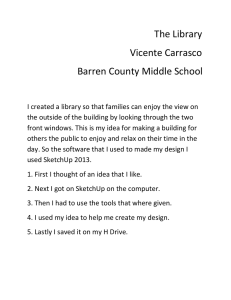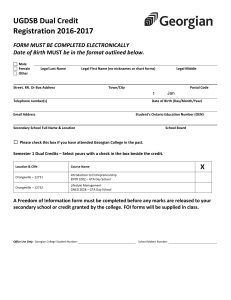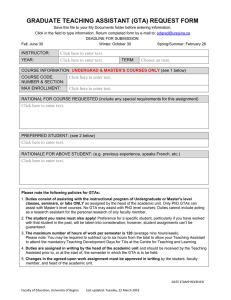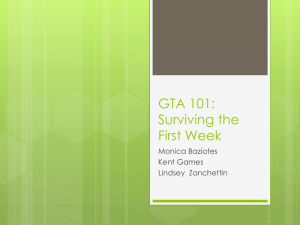to Enable Students with Quadriplegia Using 3D Modeling Phillip Baumer
advertisement
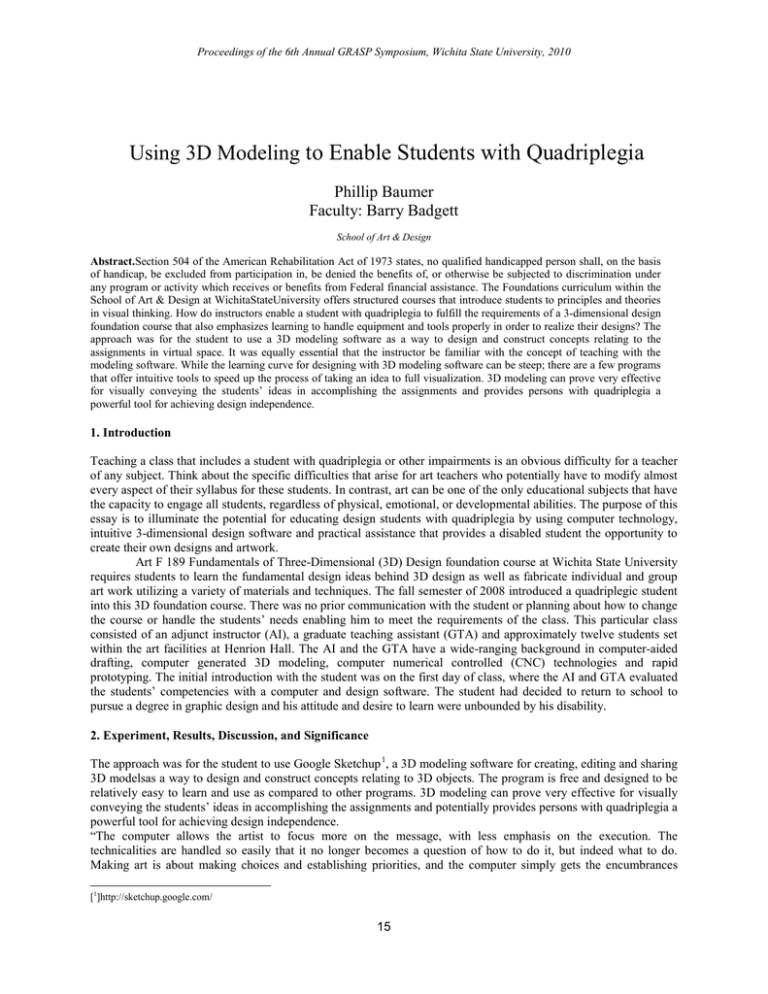
Proceedings of the 6th Annual GRASP Symposium, Wichita State University, 2010 Using 3D Modeling to Enable Students with Quadriplegia Phillip Baumer Faculty: Barry Badgett School of Art & Design Abstract.Section 504 of the American Rehabilitation Act of 1973 states, no qualified handicapped person shall, on the basis of handicap, be excluded from participation in, be denied the benefits of, or otherwise be subjected to discrimination under any program or activity which receives or benefits from Federal financial assistance. The Foundations curriculum within the School of Art & Design at WichitaStateUniversity offers structured courses that introduce students to principles and theories in visual thinking. How do instructors enable a student with quadriplegia to fulfill the requirements of a 3-dimensional design foundation course that also emphasizes learning to handle equipment and tools properly in order to realize their designs? The approach was for the student to use a 3D modeling software as a way to design and construct concepts relating to the assignments in virtual space. It was equally essential that the instructor be familiar with the concept of teaching with the modeling software. While the learning curve for designing with 3D modeling software can be steep; there are a few programs that offer intuitive tools to speed up the process of taking an idea to full visualization. 3D modeling can prove very effective for visually conveying the students’ ideas in accomplishing the assignments and provides persons with quadriplegia a powerful tool for achieving design independence. 1. Introduction Teaching a class that includes a student with quadriplegia or other impairments is an obvious difficulty for a teacher of any subject. Think about the specific difficulties that arise for art teachers who potentially have to modify almost every aspect of their syllabus for these students. In contrast, art can be one of the only educational subjects that have the capacity to engage all students, regardless of physical, emotional, or developmental abilities. The purpose of this essay is to illuminate the potential for educating design students with quadriplegia by using computer technology, intuitive 3-dimensional design software and practical assistance that provides a disabled student the opportunity to create their own designs and artwork. Art F 189 Fundamentals of Three-Dimensional (3D) Design foundation course at Wichita State University requires students to learn the fundamental design ideas behind 3D design as well as fabricate individual and group art work utilizing a variety of materials and techniques. The fall semester of 2008 introduced a quadriplegic student into this 3D foundation course. There was no prior communication with the student or planning about how to change the course or handle the students’ needs enabling him to meet the requirements of the class. This particular class consisted of an adjunct instructor (AI), a graduate teaching assistant (GTA) and approximately twelve students set within the art facilities at Henrion Hall. The AI and the GTA have a wide-ranging background in computer-aided drafting, computer generated 3D modeling, computer numerical controlled (CNC) technologies and rapid prototyping. The initial introduction with the student was on the first day of class, where the AI and GTA evaluated the students’ competencies with a computer and design software. The student had decided to return to school to pursue a degree in graphic design and his attitude and desire to learn were unbounded by his disability. 2. Experiment, Results, Discussion, and Significance The approach was for the student to use Google Sketchup 1, a 3D modeling software for creating, editing and sharing 3D modelsas a way to design and construct concepts relating to 3D objects. The program is free and designed to be relatively easy to learn and use as compared to other programs. 3D modeling can prove very effective for visually conveying the students’ ideas in accomplishing the assignments and potentially provides persons with quadriplegia a powerful tool for achieving design independence. “The computer allows the artist to focus more on the message, with less emphasis on the execution. The technicalities are handled so easily that it no longer becomes a question of how to do it, but indeed what to do. Making art is about making choices and establishing priorities, and the computer simply gets the encumbrances [1]http://sketchup.google.com/ 15 Proceedings of the 6th Annual GRASP Symposium, Wichita State University, 2010 [impairment] out of the way and lets the artist combine variables until his or her intentions are realized.” [ 2] Nearly all students, disabled and non-disabled learn in similar ways because they are using similar mental processes. When a student is interactive with a computer, the disability is unidentifiable and computer technology can potentially offer disabled students an inclusion in the process of art making. Utilizing two existing tall tables, a board to span the tables and a cordless drill case, the GTA assembled a make-shift workstation for the student in the same room as the other students. The workstation was tall enough for him to roll his electric wheelchair under and reach his laptop which was set on top of the drill case. The student provided his own laptop, roller-ball mouse and mouth stick (a pencil which he used to move the roller-ball around and navigate his computer). The GTA would set up the computer and access the software for the student. With Sketchup open, the student would virtually build his project to meet the requirements of the particular assignment and at the end of the class the GTA would pack up the students’ computer and break down the make-shift workstation. The student quickly learned Sketchup through online tutorials and practice. On occasion the GTA would demonstrate techniques with the software that the student needed in order to create his projects. The course description explains the class as a studio class that instructs in the basics of making 3D art. The format is problem solving and assignments are given in the form of provocations to which the student gives solutions by making a 3D object. The objective of this course is to develop a working knowledge of design principles used in making 3D art and to promote experimentation in resolving ideas.[ 3] It was very laborious for the student to create his projects on the computer only using the mouth stick, but he worked outside of class at length to complete the assignments. In the group assignment, the student modeled the project in 3D and the other students built the project based off of his design with a few modifications. He also participated in critiques; other students were able to engage with the students’ art by having the model rotated on the computer to visibly communicate its 3D properties. Inclusion was paramount for the student to get the full exposure of the studio class experience. He was able to communicate his initial ideas to other students and receive comments for bettering his art projects. Some experts consider this the essence of mainstreaming, an effective education process for some handicapped students. In this case, the effective mainstreaming required a student with motivation and persistence to learn, the 3D expertise of the IA and GTA and an ADA compliant facility to create an optimal teaching environment and solution. . 3. Conclusions. With only one semester, there seems to be sufficient evidence to show that students with disabilities enrolling in a 3D class can benefit from computer 3D modeling in order to have greater autonomy in the creation of their art. In particular, the program Sketchup proved to be a powerful tool for self-expression without the aid of another individual. With refinement and potential university acceptance and assistance, disabled students may have the opportunity to be equipped with the skills and competencies to gain qualifications and potential employment. 4. Acknowledgements. I would like to acknowledge Steve Atwood, the adjunct instructor for the class as mentioned above. His mechanical and computer knowledge is unmatched. I would also like to acknowledge the student who was the subject of this paper. It was his tenacity and persistence to complete the course that inspired this paper and I hope that he remembers how capable he is. Organic Machine (to be built only using one 2x6) [2] P. Callow, Some Thoughts on the Use of Digital Media in Secondary Art and Design in Becta ICT Research. A report on the use of information and communications technology (ICT) in art and design (2003), p.17. [3] Barry Badgett, Art F 189: Fundamentals of Three-Dimensional Design Syllabus. 16
